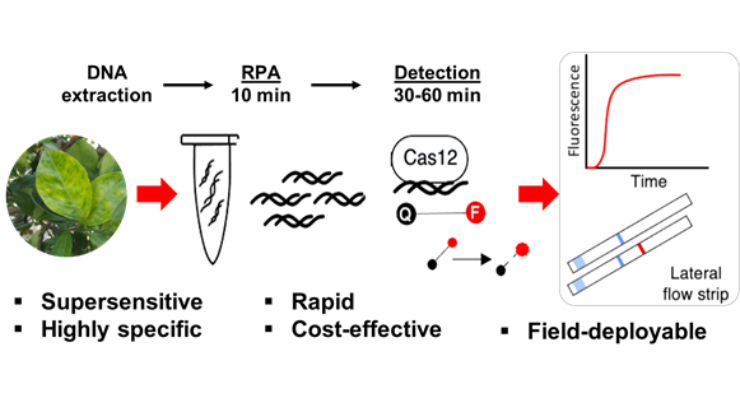Super-sensitive Detection of Citrus Greening Pathogen
ID# 2022-5430
Technology Summary
Citrus greening disease threatens worldwide citrus production. This CRISPR/Cas diagnostic detects the causal bacterial agent, Candidatus Liberibacter asiaticus (“CLas”), at a sensitivity level 100 to 1,000 times greater than the commonly used diagnostic test, quantitative polymerase chain reaction, or qPCR. The assay mixes Cas12a, CRISPR RNA, a fluorescent reporter oligonucleotide and pathogen DNA. The crRNA guides the Cas12a to bind and cleave specific DNA target site in the pathogen’s DNA. The cleavage unleashes the reporter oligonucleotide to generate a telltale fluorescent signal detectable by a fluorescence microplate reader. The highly sensitive and specific assay can also be configured for a field-deployable, visual read with a lateral flow strip. The assay successfully detected and confirmed the presence of CLas nucleic acids in infected samples collected from Florida.
Application & Market Utility
Citrus greening has decimated Florida’s orange crop by over 70% since its arrival in 2005. Having spread via an insect host to Texas, California, Georgia and Louisiana, this pathogen threatens the $3.35 billion U.S. citrus industry. Early detection is crucial to remove infected, asymptomatic trees. These trees can serve as a disease reservoir for months or years before showing the visible symptoms of asymmetrical yellowing of the leaves and leaf veins and producing green, bitter and deformed fruit. This assay offers a tool to help maintain a healthy orange orchard.
Next Steps
An ongoing collaboration with USDA APHIS to standardize the invention’s protocol.

